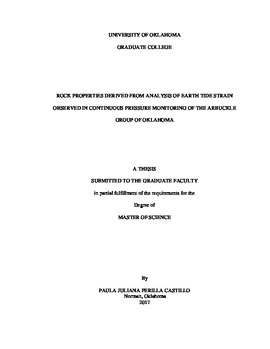| dc.description.abstract | The Arbuckle Group is an important geologic unit in the state of Oklahoma because of its suitability as a saltwater disposal (SWD) zone. In 2014, the Arbuckle Group received about 68% of the total volumes of saltwater disposal in the state of Oklahoma. Numerous studies show that the rate of saltwater injection into the Arbuckle Group is related to the number and magnitude of earthquakes occurring in Oklahoma. Despite the importance of the Arbuckle Group as a SWD zone and its apparent relationship to induced seismicity, the hydraulic parameters of the Arbuckle Group have not been widely studied or were studied in association with the Simpson Group.
Since the mid-20th century, water level fluctuations as a response to earth tides have been used for obtaining aquifer properties of confined and unconfined aquifers. In confined aquifers, earth tides act as a cyclic stress causing water level fluctuations. Time-series analyses of the fluctuations can be used for estimating elastic properties of an aquifer and aquifer hydraulic properties such as specific storage, storage coefficient, transmissivity, porosity, matrix compressibility, hydraulic conductivity, and hydraulic diffusivity. Solid earth tide analysis is a useful tool for calculating rock properties in aquifers or reservoirs where it is not practical to conduct a pumping or a slug test. Confined reservoirs such as the Arbuckle Group respond to small strains and act as volume strain meters.
In 2016, a network of inactive Arbuckle SWD wells were instrumented so that pressure fluctuations could be monitored and analyzed. For this thesis research, fluid levels in six of the study wells were evaluated. Fluid levels responded to solid earth tide stresses so that 90-day time series could be analyzed and used to estimate hydraulic and rock properties of the Arbuckle Group in the Anadarko Shelf and the Cherokee Platform geological provinces of Oklahoma. Hydraulic parameters derived from these analysis of these data include median values of 1.39 E-06 m-1 specific storage, 3.69 E-04 storage coefficient, 12.76 m2/d transmissivity, 24% porosity, 3.02 E-07 psi-1 matrix compressibility, 2.21 E-07 m/s hydraulic conductivity, 34.37 mD intrinsic permeability, and 0.69 m2/s hydraulic diffusivity. Values obtained for each of the properties computed in this study differ from the values used in previous studies that modeled the effects of saltwater disposal on subsurface fluid pressure and potential connections to seismicity. These improved values will allow for more realistic predictions of subsurface fluid behavior, pore pressure diffusion, and other geomechanical and seismological processes. | en_US |
